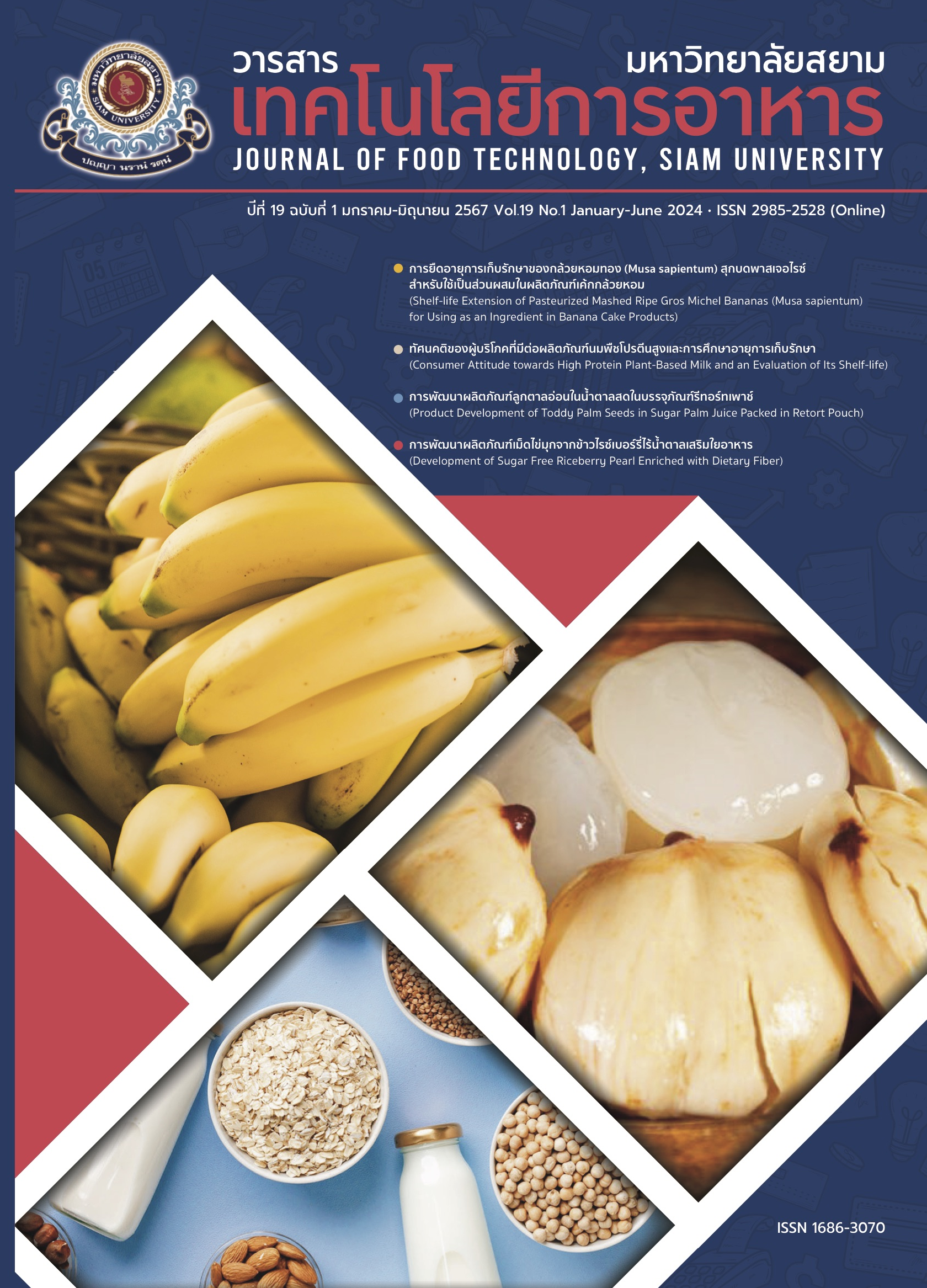การพัฒนาผลิตภัณฑ์เม็ดไข่มุกจากข้าวไรซ์เบอร์รี่ไร้น้ำตาลเสริมใยอาหาร
Main Article Content
บทคัดย่อ
งานวิจัยนี้มีวัตถุประสงค์เพื่อพัฒนาผลิตภัณฑ์เม็ดไข่มุกเพื่อสุขภาพจากข้าวไรซ์เบอร์รี่ โดยทำการคัดเลือกสูตรพื้นฐานและศึกษาอัตราส่วนที่เหมาะสมของการใช้แป้งข้าวไรซ์เบอร์รี่ทดแทนแป้งมันสำปะหลังที่ 5 ระดับ คือ 0:100, 25:75, 50:50, 75:25 และ 100:0 แปรระดับการต้มเม็ดไข่มุกเป็นระยะเวลานาน 35, 40, 45 นาที ผลการทดลอง พบว่า เมื่อเพิ่มปริมาณแป้งข้าวไรซ์เบอร์รี่มากขึ้นและต้มเป็นระยะเวลาที่นานขึ้นส่งผลให้เม็ดไข่มุกที่ได้มีค่า hardness และ springiness ที่ลดลง อัตราส่วนที่เหมาะสม คือ 25:75 (แป้งข้าวไรซ์เบอร์รี่:แป้งมันสำปะหลัง) โดยต้มเม็ดไข่มุกเป็นระยะเวลานาน 40 นาที ได้รับคะแนนความชอบโดยรวมสูงที่สุด การศึกษาปริมาณของบุกเพื่อเพิ่มใยอาหารในเม็ดไข่มุกจากข้าวไรซ์เบอร์รี่ที่ระดับ ร้อยละ 0, 5 และ 10 พบว่าระดับที่เหมาะสมคือ ร้อยละ 10 การเติมบุกทำให้เม็ดไข่มุกมีเนื้อสัมผัสเหนียวและหนึบขึ้นโดยมีค่า springiness (1.42N) และ gumminess (3.21N) ที่เพิ่มขึ้นจากตัวอย่างควบคุม การพัฒนาสูตรโดยการศึกษาอัตราส่วนของซูคราโลส สารให้ความหวานแทนน้ำตาลทรายแดง พบว่า สามารถใช้ซูคราโลสที่ร้อยละ 0.42 (ร้อยละโดยน้ำหนัก) ทดแทนน้ำตาลทรายแดงในสูตรควบคุมได้ร้อยละ 100 โดยสูตรดังกล่าว มีปริมาณน้ำตาลรีดิวซ์เท่ากับ 5.84 g/100g ซึ่งมีปริมาณน้อยกว่าตัวอย่างควบคุม (16.50 g/100g) ประมาณ 3 เท่า นอกจากนี้สูตรที่ผ่านการพัฒนามีความชื้น ร้อยละ 23.85 เถ้า ร้อยละ 0.30 โปรตีน ร้อยละ 2.10 ไขมัน ร้อยละ 0.95 เส้นใยหยาบ ร้อยละ 2.12 และคาร์โบไฮเดรต ร้อยละ 70.68 มีคุณภาพด้านจุลินทรีย์และยีสต์และราทั้งหมด 0 cfu/g การทดสอบผู้โดยบริโภค 200 คน ที่มีต่อผลิตภัณฑ์เม็ดไข่มุกเพื่อสุขภาพจากข้าวไรซ์เบอร์รี่ที่ผ่านการพัฒนา พบว่า ผู้บริโภคยอมรับผลิตภัณฑ์ ร้อยละ 94 และสนใจซื้อผลิตภัณฑ์ ร้อยละ 92
Article Details

อนุญาตภายใต้เงื่อนไข Creative Commons Attribution-NonCommercial-NoDerivatives 4.0 International License.
บทความทุกบทความในวารสารเทคโนโลยีการอาหาร ทั้งในรูปแบบสิ่งพิมพ์ และในระบบออนไลน์ ถือเป็นลิขสิทธิ์ของมหาวิทยาลัยสยาม และได้รับการคุ้มครองตามกฎหมาย
เอกสารอ้างอิง
Krungsri Research. (2024). Business/industry trends 2022-2024: beverage industry. [Online] Available from https://www.krungsri.com/th/research/industry/industry-outlook/food-beverage/beverage/io/io-beverage-2022 [Accessed March 18, 2024].
Phothipiranan, B. (2016). Factors affecting bubble milk tea consumption. Case study of tea more shop. Master's thesis, Rajamangala University of Technology PhraNakhon, Bangkok.
Insightsconnectasia. In-depth look at bubble milk tea for Thai people and people in SEA. [Online] Available from https://insights.nconnect.asia/bubble-tea-insights-in-southeast-asia-and-thailand/ [Accessed March 18, 2024].
Leelawat, B., Tilokkul, R. and Baikhunakon, M. (2020). Development of kaimook from purple rice. Thai Science and Technology Journal (TSTJ). 28(3): 455-465. (in Thai).
Bureau of Information Office of The Permanent Secretary of MOPH. (2022). Department of Disease Control reveals the situation of diabetes around the world. There are 537 million people already sick, up to 6.7 million deaths, or 1 death every 5 seconds. [Online] Available from https://pr.moph.go.th/?url=pr/detail/2/02/181256/ [Accessed October 5, 2023].
Vatanasuchart, N., Boonma, N. and Karuna, W. (2009). Resistant starch contents and the in vitro starch digestibility of Thai Starchy Foods. Kasetsart Journal (Natural Science). 43: 178-186.
Thongtaeng, N. (2021). Non-Communicable Disease. Faculty of Medicine Siriraj Hospital. [Online] Available from https://www.si.mahidol.ac.th/sidoctor/sirirajonline2021/Article_files/1371_1.pdf. [Accessed October 5, 2023].
Raungrusmee, S., Sushil, K. and Anil, K.A. (2022). Effect of physicochemical modification on granule morphology, pasting behavior, and functional properties of riceberry rice (Oryza Sativa L.) starch. Food Chemistry Advances. 1: 1-9.
Rice Family Thailand. (2023). Riceberry rice. [Online] Available from https://www.thairicedb.com/rice-detail.php?id=15 [Accessed October 5, 2023].
Matangkasombut, O. and Thanyasrisung, P. (2019). Sugar substitutes and their effects on systemic and oral health. The Dental Association of Thailand Journal. 69(4): 379-397. (in Thai).
Whamak, S., Chuaireung, W. and Chaichareon, T. (2018). Effect of partial substitution of wheat flour with riceberry flour on quality of mantou. Proceedings of the 4th Pibulsongkram Research National Conference, pp 61-64. March 23, 2018. Bangkok. Thailand.
Beamy, K. (2021). How to make easy brown sugar pearls with only 3 ingredients, you can cook it by yourself at home. [Online] Available from https://food.trueid.net/detail/zkjwQrKJdDWy [Accessed October 1, 2023].
Monkeytan. (2019). How to make soft and chewy Taiwanese pearls recipe. [Online] Available from https://food.mthai.com/dessert/142108.html [Accessed October 1, 2023].
Spring Green Evolution. (2023). How to make soft and chewy pearls, just as delicious as the store. [Online] Available from https://www.sgethai.com/article/%E0%B9%84%E0%B8%82%E0%B9%88%E0%B8%A1%E0%B8%B8%E0%B8%81/ [Accessed October 1, 2023].
Davis, A.R., Fish, W.W. and Veazie, P.P. (2003). A rapid spectrophotometric method for analyzing lycopene content in tomato and tomato products. Postharvest Biology and Technology. 28: 425-430.
AOAC. (2012). Official method of analysis. (19thed.). Association of Official Analytical Chemists. Washington D.C.
Mcorist, A.L., Miller, R.B., Bird, A.R., Keogh, J.B., Noakes, M., Topping, D.L. and Conlon, M.A. (2011). Fecal butyrate levels vary widely among individuals but are usually increased by a diet high in resistant starch. The Journal of Nutrition. 141: 883-889.
AOAC. (2016). Official Methods of Analysis of AOAC International. Gaithersburg, MD, USA: AOAC International.
BAM. (2002). Food and Drug Administration Bacteriological Analytical Manual. (8thed)., AOAC International, USA.
Williams, L.J. and Abdi, H. (2010). Fisher’s Least Significant Difference (LSD) Test. In N. Salkind. (ed.), Encyclopedia of Research Design. (pp.154). Sage, Thousand Oaks.
Srirod, K. and Piyajomkwan, K. (2007). Starch technology. (4thed.). Publisher Kasetsart University, Bangkok.
Podjanalekha, P., Saenmuang, S. and Phothiset, S. (2018). Effect of temperatures on physicochemical properties of riceberry flour after modification by heat-moisture treatment. Journal of Khon Kaen Agriculture, Kasetsart University. 46(1):212-217. (in Thai).
Naiwikul, O. (2004). Rice: Science and Technology. Kasetsart University, Bangkok. (in Thai).
Kibar, E.A.A., Gönenc, I. and Us, F. (2010). Gelatinization of waxy, normal and high amylose corn starches. GIDA. 35(4): 237-244.
Pongsawatmanita, R., Parita, T. and Shinya, I. (2002). Effect of sucrose on RVA viscosity parameters, water activity and freezable water fraction of cassava starch suspensions. ScienceAsia. 28: 129-134.
Colmenero, F.J. (1996). Technologies for developing low-fat meat product. Trends in Food Science and Technology. 7: 41-48.
Villamiel, M., Del Castillo, M.D., Corzo, N. (2006). Browning Reactions. In Food biochemistry and food processing. Wiley-Blackwell. pp. 83–85. Ames, Iowa.
Medthai. (2020). Sugar, properties and benefits of sugar 14! (sugar). [Online] Available from https://medthai.com/%e0%b8%99%e0%b9%89%e0%b8%b3%e0%b8%95%e0%b8%b2%e0%b8%a5/ [Accessed October 12, 2023].
HealthToday (2009). Can be sweet, does not harm health. [Online] Available from http://www.yourhealthyguide.com/article/an-sweet-healthy.html [Accessed October 12, 2023].
Office of Nutrition. (2018). Department of Health. Food composition table of Thai foods., 1,800. (1st ed.). War Veterans Organization Thai Printing, Bangkok. (in Thai).
Food Research for Nutrition Section. (2018). Nutrition of Cassava flour. [Online] Available from from https://thaifcd.anamai.moph.go.th/nss/view.php?fID=02016 [Accessed October 15, 2023].
Pinwattana, K., Sueaman, K., Paksee, S., Arpsuwan, A., Sam-ang, P., Jannoey, P. and Chalongsuppunyoo, R. (2019). Determination of antioxidant capacity of riceberry and khao dok mali 105 cultivars. PSRU Journal of Science and Technology. 4(3): 95-108. (in Thai).
Yawadio, R., Tanimori, S. and Morita, N. (2007). Identification of Phenolic compounds isolated from pigmented rices and their aldose reductase inhibitory activities. Food Chemistry. 101(4): 1616-1625.
Department of Science Service. (2010). Anthocyanin. Ministry of Science and Technology. Bangkok. (in Thai).
Janead, J. (2021). Marketing mix factors and consumer’s behavior of bubble tea in Songkhla Municipality, Songkhla Province. Public Administration Academic Conference National level. 13: 193-207.


